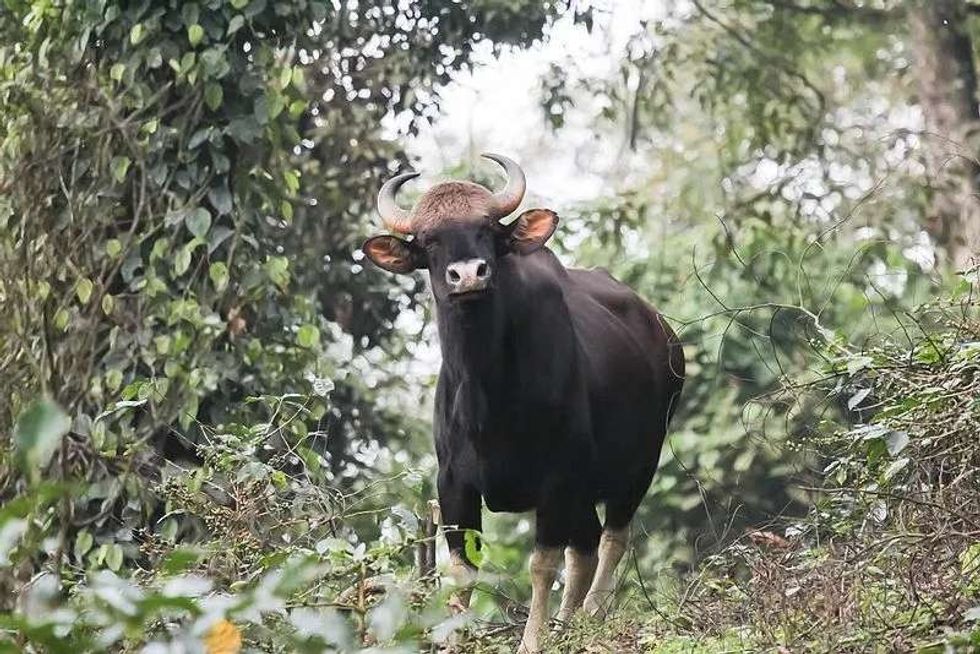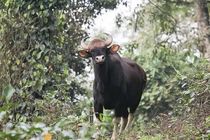The gaur, also known as Indian bison, is a species of bovine native to South and Southeast Asia and was extirpated from Sri Lanka and Bangladesh and so now is protected in these areas with stable and increasing population.
It is the largest species in the wild cattle of the family Bovidae and is also called Seladang in Malaysia and Pyaung in Myanmar.
Gayal or Bos gaurus is the domesticated form of gaur.
Their population is known to be shrinking in Sri Lanka.
These animals are huge in size and those which are not domesticated can be quite scary as they can chase humans and hurt them with their horns if they feel threatened. Therefore, you must ignore them if spotted.
In India and some parts of Asia, they have been domesticated. The gaur bull is mainly confined to evergreen forest, semi-evergreen and deciduous forest.
In the mid-1990s, there were only 250-350 gaur bulls left in Chitwan National Park and the adjacent Parse National Park. In some countries like Thailand, the gaur bull is highly threatened by poaching for commercial trade as meat and trophies. They are considered to indicate wealth and good luck in some cultures.
It is also the state animal of Goa and Bihar, in India. Read on for more facts.
For more relatable content, check out these plains bison facts and blue wildebeest facts for kids.
Gaur Interesting Facts
What type of animal is a gaur?
The gaur (Bos gaurus) is a type of bull that is reddish or brown and black in color and the limbs are pale-colored. They are mostly active in the morning and evening.
What class of animal does a gaur belong to?
The gaur (Bos gaurus) belongs to class Mammalia and phylum Chordata.
How many gaurs are there in the world?
As per the IUCN Red List, the total number of gaur bulls varies from 13,000-30,000. Their population has been decreasing and is listed as Vulnerable according to the IUCN Red List.
Where does a gaur live?
A gaur lives in evergreen, semi-green and deciduous forest native to South and Southeast Asia including Laos, Vietnam, India, Bangladesh, Bhutan, China, Peninsular Malaysia, and Nepal.
What is a gaur's habitat?
A gaur herd is mainly confined to evergreen, semi-green and deciduous forests. They are nocturnal in nature when living in human settlements and are most active during morning and evening.
Mostly they come over in herds including 8-11 individuals of the gaur bull as well as a gaur herd containing one dominant male and other females. They lead a solitary life. As per their habitat, these animals in herds make a whistling snort when they want to call.
Habitat also involves living in the dry forests of India. They play a very important role in their habitat and help in controlling communities and ecosystems.
Who do gaurs live with?
The gaur (Bos gaurus) lives in herds or gangs or obstinacy of 8-11 individuals which contains one dominant male and other females.
How long does a gaur live?
A bull gaur has a lifespan of around 30 years in captivity. In some areas, these animals inhabit high elevations up to 5,905.5 ft (1,800 m).
How do they reproduce?
The gaur (Bos gaurus) has a polygynous mating system which means one male is capable of mating with different females, mating occurs in their second or third year. The breeding season mainly occurs in December and June.
During this process, males call in resonant tones to attract receptive females whereas the bulls who are bigger in size are more successful in attracting females.
The gestation period is around 275 days less than domestic cattle, a period of 12-15 months is there for females between births yielding a single baby calf.
The weight of a baby calf is nearly 50 lb (22.7 kg), the calf is weaned at the age of nine months and they become sexually active at the age of two to three years. The adult males are called bull while females are called cow and baby gaur is called as a calf.
What is their conservation status?
These animals of species Bos gaurus are Vulnerable according to the IUCN Red List but it is usually protected in all range states. The Bos frontalis population trend is decreasing.
Gaur Fun Facts
What do gaurs look like?
The Bos gaurus or gaur is reddish-brown or blackish-brown in color with white stockings and comparatively adult males are quite heavy from adult females.
They have a muscular hump above their shoulders whereas elongated spinal processes are present on the vertebrae.
The largest wild cattle species has a massive head, deep body, and solid limbs. Males and females of small herds have covered horns on the side of their head, the horns are of yellow base and black tip and hump on shoulders are prominent in adult males.
This species of bulls is massively built with high convex ridge, ears of these animals very large and the tail of gaur reach till the hocks and very thin layer of hairs are there in the old bulls.
The muzzle in these animals is pale-colored, and the lower part of the legs in young ones are pure white or tan and the body color is dark brown.
Young bulls have paler body coloration, and in some instances, with a rufous tinge, which is most marked in small herds group inhabiting dry and open districts. The body length to head is 8.2-10.8 ft (2.5-3.3 m), the tail is about 2.3-3.5 ft (0.7-1.1 m) and the height of shoulders is about 5.4-7.2 ft (1.6-2.2 m).
Both males and females have horns of length about 2-3.5 ft (0.6-1.1 m).
They are the largest land animals living native to Thailand, Malaysia, Southeast Asia and they are rugged at the base.

How cute are they?
Species of gaurs are not cute. They are quite dangerous, especially gaurs living in the Indian jungle as they are extremely agile in nature and sometimes aggressive. They gaze across domestic cattle and are known to sometimes killing them during fights.
How do they communicate?
No such communication process or method is given for these herds till now but when they feel aggressive or are hungry they make a loud sound.
How big is a gaur?
The Indian gaur bull has different sizes, depending on the sex. The male is around 74 in (188 cm), whereas, females have a body size of around 66.1 in (168 cm). They are 15 times bigger than Highland cattle.
How fast can a gaur move?
Gaur can run up to a speed of 35 mph (56.3 kph) which could be compared to a horse and these animals can turn quickly and jump fences because they are extremely agile.
How much does a gaur weigh?
The Indian gaur can weigh up to 1,433-3,307 lb (650-1,500 kg). They are five to six times bigger than zebras.
What are the male and female names of the species?
The male species of gaurs are known as bulls and the female species of gaur are known as cows in the wild.
What would you call a baby gaur?
A young gaur is called a calf. The young ones weigh around 50 lb (22.7 kg) on average and these baby gaurs are dark brown in color.
What do they eat?
Gaurs have an herbivorous diet and they mainly rely on a variety of plants, leaves, and shrubs. They graze at everything found in forests or jungles.
Their diet also contains fruits, seeds, stems, flowers, and many more sometimes which provides them nutrition because they have an extremely variable diet. Their diet varies from season to season depending upon the climate.
Gaurs eat something called kadam (Adina Cordifolia) and they are dependent on the fibrous teak bark in summer which provides a high concentration of calcium and phosphorus as the leaves, grass, and shrubs get dry. Long-term survival of gaurs is only possible when they are dependent on the availability of preferred plant species for food.
As this animal is both grazer and browser it also feeds on coarse and forbs which is a good supplement to its usual diet. After eating, they rest in the shed of large trees.
Are they dangerous?
The Indian gaur is the most dangerous animal in the jungles of India. Gaurs are those animals that are good to watch in places like zoos or in national parks from a safari vehicle.
They are capable of hunting tigers by running at a fast speed. The Indian gaur bull is not as aggressive towards humans as the other gaur in the wild cattle.
Would they make a good pet?
The domestic form of the population of gaurs is known as gayal or mithun. This herd produces nutritious milk and also produces some amount of leather which is used by people and helps in making money.
Although, species of gaurs are not domesticated by the Indian populations because among all the wild cattle in the world this herd is known to be an ultimate ungulate.
Did you know...
In North America, the cattle and hybrids were evaluated in Canada. Sometimes it is difficult for the human population to reach gaurs as they are shy in nature and these domestic herds live in Asia.
Gaurs vs bisons
The gaur, also known as the Indian bison, is a bovine of the same family. The gaur population in India occurs in more or less isolated corresponding to the major mountain systems of the Western Ghats, the central Indian highlands, and the northeastern Himalayas.
Both gaur and Indian bison are vulnerable in the Red List of IUCN. The Indian bison is also found native to southeast Asia and in India, it is found in Nagarhole, Bandipur, Masinapuri National Park, and BR hills.
How to pronounce 'gaur'
Gaur is pronounced as 'Gaa-ur' or 'Gou-uur'.
Here at Kidadl, we have carefully created lots of interesting family-friendly animal facts for everyone to discover! Learn more about some other mammals from our Beabull facts and water buffalo facts pages.
You can even occupy yourself at home by coloring in one of our free printable Gaur coloring pages.









